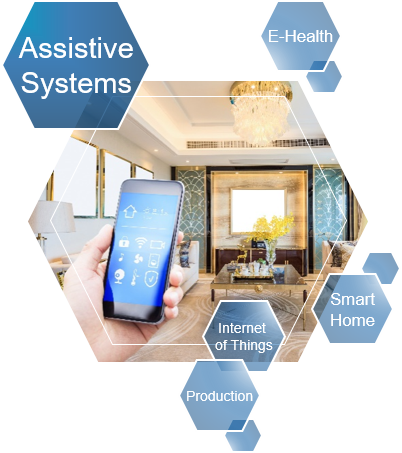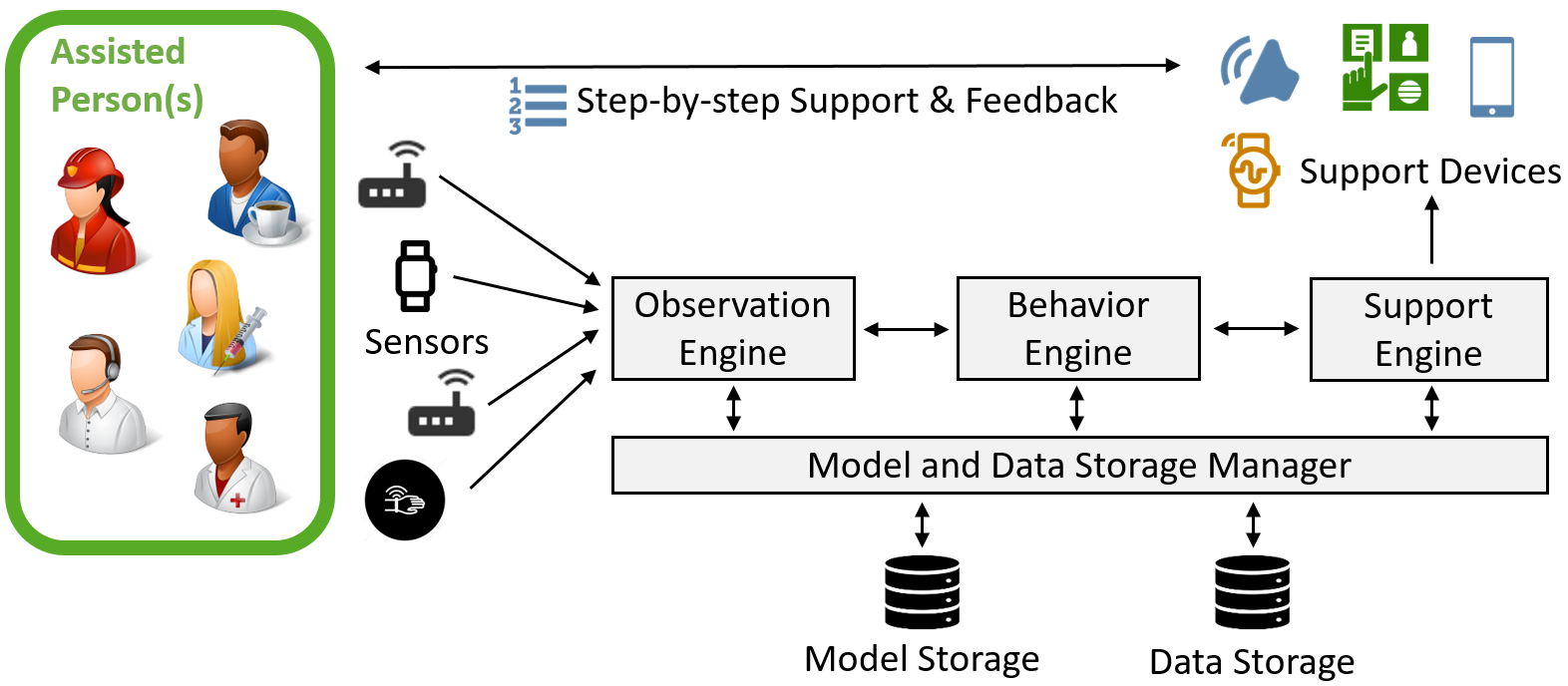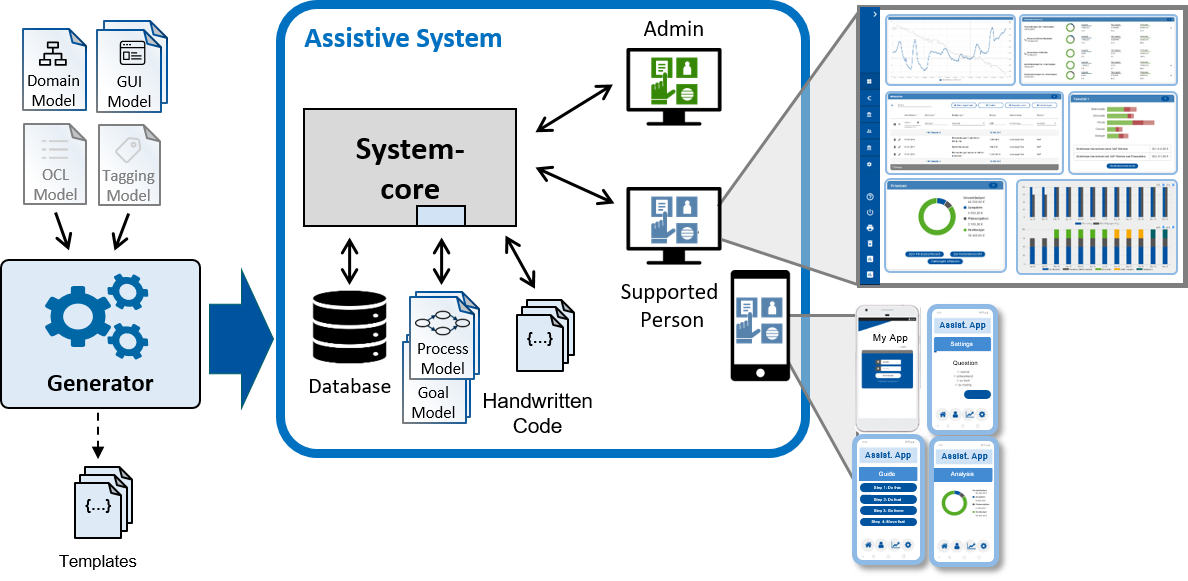Model-Based Assistive Systems
Summary of Most Relevant Topic Papers

Assistive systems offer people support in a wide variety of situations. This can be relevant in all areas of life, from our private home, in health care, in vehicles or in the professional world. If we consider our own home, such an assistive system can help us when we forget things. Assistive systems use information about processes and context information, e.g., about rooms, objects in the rooms or devices we are interacting with.
Assistive systems [HMR+19]
- provide situational support for human behaviour
- based on information from previously stored and real-time monitored structural context and behaviour data
- at the time the person needs or asks for it.
The main components of an assistive system according to the architectural patterns for model centered architecture solutions [MMR+17] are sensors, storages, observation components, a behavior engine, and support components. Information about human behavior is collected via sensors, e.g., via sensor floors [LMK+11] or smart devices and processed in observation components, which stores the data and models. The behavior engine compares and connects the current behavior step with already existing models of behavior. The support engine decides which next step should be provided as behavior support for the assisted person. This support can be provided as step-by-step information multi-modal on different kinds of devices.

For both, information and assistive services and systems, the application of agile, model-based and generative methods fastens the development process, enables a quick response to requirements changes in a user-centered engineering process, and ensures consistency-by-design.
Our current work on assistive systems is based on former work within the Human Behavior Monitoring and Support (HBMS) project [MSS+18] in which a domain specific language [MM13] including structural and behavior data, and domain specific modeling method for assistive systems [MM15] were developed. A technique for using goal modeling languages [MRV20] or UML/P based languages [MNRV19] describes, how languages for assistive systems can be created.
Current work extends these approaches: to enable useful support, it is important to know more than just the behavior of a person. Context-aware systems need detailed information about the task context (including temporal information), the personal and social context, the environmental context, as well as the spatial context. We have investigated the modeling of these contexts primary for the active assisted living and smart home domain [MS17]. Recent research discusses the context model for user-centered privacy-driven systems in the IoT domain including special aspects for the use in combination with process mining systems [MKM+19].
The mark-up of online manuals for non-smart devices [SM18] as well as websites [SM20] is one further step to provide human-centered assistance. Using these approaches reduces system set-up time and improves flexibility for changes by automatically integrating device and application functionality into supporting systems.
Due to the General Data Protection Regulation (GDPR) organizations are obliged to consider privacy throughout the complete development process, which is also relevant for assistive systems. Our work suggests solutions for privacy-aware environments for cloud services [ELR+17] as well as privacy preserving information systems demonstrated on an IoT manufacturing use case [MNRV19].

We are successfully using the generator framework MontiGem [AMN+20a] to create assistive systems for smart homes supporting, e.g., cooking processes. Process and context models allow us to generate web-based multi-modal user interfaces that compose supporting texts from model information and provide pictures and audio support. We cover concepts for leading users to find or place objects using spatial relationships and object nesting. Within assistive systems, we can use different kinds of DSLs for generation and during runtime, e.g., we are investigating how goal modeling can be used as addition to behavior modeling languages [MRZ21] and how to define context information and user tasks.
![]()
Key Statements
- The engineering of interactive assistive systems is challenging as they might support critical functionality in dangerous environments and have a high need for safety and privacy considerations due to the processing of personal data about human behavior.
- Using agile, model-based and generative methods fastens the development process, enables a quick response to requirements changes in a user-centered engineering process, and ensures consistency-by-design.
- There are still challenges to overcome such as the high amount of relevant contextual information needed to set-up such systems or high adaptability requirements to personal needs.
![]()
Selected Topic-Specific Publications
-
[MRZ21]In: Int. Conf. on Model Driven Engineering Languages and Systems Companion (MODELS-C), pp. 370-379, ACM/IEEE, Oct. 2021.
-
[MRV20]In: Enterprise Modeling and Information Systems Architectures (EMSIA 2020), A. Koschmider, J. Michael, B. Thalheim (Eds.), Volume 2628, pp. 11-18, CEUR Workshop Proceedings, Jun. 2020.
-
[AMN+20a]In: 40 Years EMISA: Digital Ecosystems of the Future: Methodology, Techniques and Applications (EMISA’19), Volume P-304, pp. 59-66, LNI, Gesellschaft für Informatik e.V., May 2020.
-
[SM20]In: Smart Assisted Living: Toward An Open Smart-Home Infrastructure, pp. 227-246, Computer Communications and Networks, Springer International Publishing, 2020.
-
[MNRV19]In: Proceedings of MODELS 2019. Workshop MDE4IoT, N. Ferry, A. Cicchetti, F. Ciccozzi, A. Solberg, M. Wimmer, A. Wortmann (Eds.), pp. 595-614, CEUR Workshop Proceedings, Sep. 2019.
-
[HMR+19]In: Journal of Object Technology (JOT), A. Pierantonio, M. van den Brand, B. Combemale (Eds.), Volume 18(1), pp. 1-60, DOI 10.5381/jot.2019.18.1.r1, AITO - Association Internationale pour les Technologies Objets, Jul. 2019.
-
[MKM+19]In: Proceedings of CAiSE Forum 2019: Information Systems Engineering in Responsible Information Systems, C. Cappiello, M. Ruiz (Eds.), pp. 194-206, Springer, Jun. 2019.
-
[SM18]In: EMISA Forum, Volume 38(1), pp. 35-36, Gesellschaft für Informatik e.V., Nov. 2018.
-
[MSS+18]In: Enterprise Modelling and Information Systems Architectures - International Journal of Conceptual Modeling, Volume 13, pp. 345-370, DOI 10.18417/emisa.si.hcm.26, Feb. 2018.
-
[ELR+17]In: Software Architecture for Big Data and the Cloud, I. Mistrik, R. Bahsoon, N. Ali, M. Heisel, B. Maxim (Eds.), ch. 12, pp. 207-226, Elsevier Science & Technology, Jun. 2017.
-
[MMR+17]In: Conceptual Modeling Perspectives, pp. 85-104, ISBN 978-3-319-67271-7, Springer International Publishing, 2017.
-
[MS17]In: Proc. of the ER Forum 2017 and the ER 2017 Demo Track co-located with the 36th Int. Conference on Conceptual Modelling (ER 2017), C. Cabanillas, S. España, S. Farshidi (Eds.), pp. 221-234, 2017.
-
[MM15]In: International Conference on Advances in ICT for Emerging Regions (ICTer2015), pp. 119-124, IEEE, 2015.
-
[MM13]In: Conceptual Modeling - ER 2013, Volume 8217, pp. 403-413, LNCS, ISBN 978-3-642-41923-2, Springer, 2013.
-
[LMK+11]In: 12th IEEE International Conference on Mobile Data Management (Volume 2), A. Zaslavsky, P. K. Chrysanthis, D. L. Lee, D. Chakraborty, V. Kalogeraki, M. F. Mokbel, C.- Y. Chow (Eds.), pp. 61-66, IEEE, Jun. 2011.
![]()
Related Topics
- Agile Model-Based Software Engineering
- Generative Software Engineering
- MontiCore - Language Workbench
- UML/P
- Unified Modeling Language (UML)
- Models in Enterprise Information System Development
- Digital Twins and Digital Shadows in Engineering, Operation and Production
![]()